Harnessing the power of habit formation to drive sales
 “We are, all of us, creatures of habit,” wrote Edgar Rice Burroughs in his 1916 novel ‘The Beasts of Tarzan’. In so doing, he coined an aphorism that science and psychology have subsequently proved to be more accurate and apposite than he might have imagined at the time.
“We are, all of us, creatures of habit,” wrote Edgar Rice Burroughs in his 1916 novel ‘The Beasts of Tarzan’. In so doing, he coined an aphorism that science and psychology have subsequently proved to be more accurate and apposite than he might have imagined at the time.
This very morning, each of us has subconsciously repeated the cycle of many different habits. We’ve got out of bed prompted by the siren call of an alarm. Stood bleary-eyed in front of the bathroom mirror and brushed our teeth. Grabbed a latte just how we like it at our favourite coffee shop – tendering our little black and blue loyalty card to be stamped as we did so. Glanced at the headlines in the Metro. Said “Good morning” to the smiling receptionist…the list of our repeated daily habits – routines if you like, expands as time passes.
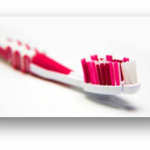
What then is a habit? In simple terms it is a behaviour done with little or no conscious thought. In psychology, ‘habits’ are defined as behavioural patterns enacted automatically in response to a situation in which the behaviour has been performed repeatedly and consistently in the past. (Verplanken & Aarts, 1999; Wood and Neal, 2009). Not only have we conditioned ourselves to behave in a particular way in a given context, recent investigation suggests that alternative actions are actually less accessible in the brain (Danner, Aarts & de Vries, 2007, 2008).
What then if you could harness the psychology of habit formation to encourage your customers to use your product, service or brand more frequently or more consistently? Well, you can. Companies that form strong customer habits enjoy several benefits to their bottom line. They successfully attach their product to internal triggers. Instead of relying on expensive marketing, habit-forming companies link their services to peoples’ daily routines and emotions. Revenues increase and costs fall.
Habit-forming products, both good and bad, have been around for decades but technology has magnified the power and potential of this approach – think Facebook, Pinterest, Twitter, Instagram, Minecraft, Candy Crush or Fitbit. These category leading brands, and many others like them, design their customer or user experience around the four stages in the habit formation cycle:-
- The Trigger
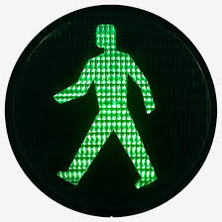 The Pavlovian external prompt that initiates the habitual behavior. ‘Green Men’, play, share and like icons, all work in this way. So too, the ‘ping’ of a new email or text arriving on your smartphone. Often the information on what to do next is contained in the trigger itself ‘Buy now’, ‘Subscribe’ and so on. Internalised triggers operate at an even deeper level – ‘I’m unsure -> I’ll Google it’ or ‘I’m lonely ->I’ll go on Facebook’.
The Pavlovian external prompt that initiates the habitual behavior. ‘Green Men’, play, share and like icons, all work in this way. So too, the ‘ping’ of a new email or text arriving on your smartphone. Often the information on what to do next is contained in the trigger itself ‘Buy now’, ‘Subscribe’ and so on. Internalised triggers operate at an even deeper level – ‘I’m unsure -> I’ll Google it’ or ‘I’m lonely ->I’ll go on Facebook’.
- The Action
Not any action but the simplest action done in anticipation of a reward of some kind. B J Fogg, an American academic at Stanford University, contends that the propensity for any human action or behavior (B) to happen rests upon the balance between motivation (M), ability (A) and the presence of a strong trigger (T). In short, the equation B = MAT. The job of the marketer is to maximise motivation and ability and then deliver compelling triggers or ideally get customers to internalise them. Fogg identifies six factors that can increase motivation and another six that can increase or decrease ability.
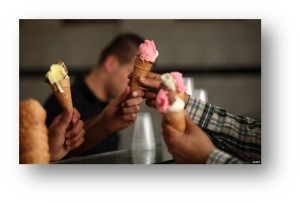
- The Reward
Neuroscience has identified that our reward system activates most powerfully in anticipation of the reward and calms when we get what we want. The thought of that first lick of ice-cream on a hot summer day is more motivating than the reality. Variability, mystery and intrigue in the reward causes focus and is highly habit forming. Habit-forming products tend to use one or more forms of variable reward which include: competitive success, completist satisfaction and the thrill of the hunt, etc.
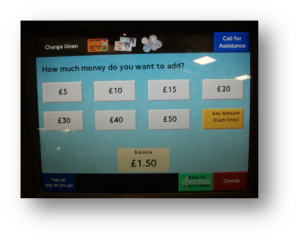
- The Investment
Whether it’s pre-loading an Oyster card with cash, creating a personalized Just Giving page or adding connections on LinkedIn, habit-forming products encourage us to make little investments that save time, reduce effort or increase the reward (monetary or emotional) of using again (and again) in the future.
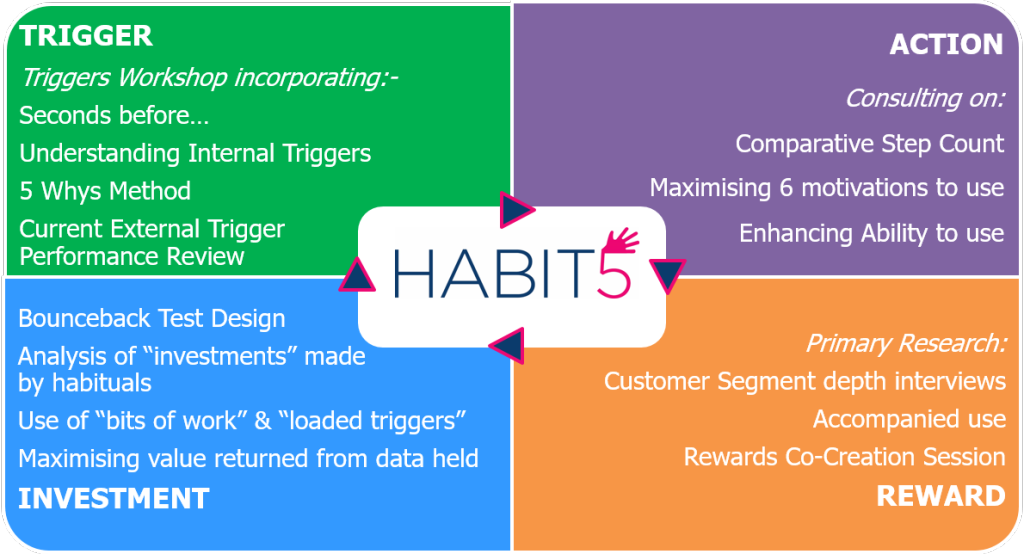
We have developed ways of helping clients make their product or service customer experience more habit-forming, at each and every stage in this cycle, as illustrated in the diagram above. This approach can be applied in any sector where it is a realistic objective to secure purchases or customer engagement with the brand at least once a quarter. Do get in touch if you would like to know more about how to go about harnessing the psychology of habit formation to grow your business or brand.
Now
What’s new and news from us at Habit5 and the wider world of human understanding
- Research Brief templates designed to improve insight
- How we can support Clients in these difficult times
- Creating a Customer Panel? With Brexit looming now really is the time!
- RESEARCH AGENCY HABIT5 IS SETTING OUT TO ENSURE THAT THE VOICES OF THE PEOPLE OF LINCOLNSHIRE ARE HEARD
- Habit5 recruits Hannah Green as our first Head of Insight
- Do something new in 2016
- How to successfully change Customer Behaviour
- Habit5 will be exhibiting at the inaugural Lincolnshire Business Expo on Thursday 21st January
- FIVE RESOLUTIONS YOU REALLY CAN ACHIEVE AT HOME & AT WORK
- Hand over the Kleenex! Why brands are determined to make us cry.
